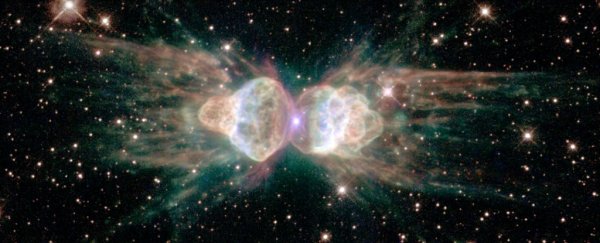There's a mystery in the dusty heart of the Ant Nebula. Its two symmetrical lobes are the result of a star shedding its material as it dies - and that's not usually a shape seen in this sort of event.
One hypothesis is that the dense gas at the core of the nebula - also known as Menzel 3 - conceals a binary companion to the dying star. And now new data from a dead telescope have revealed a rare laser emission phenomenon that seems to confirm the presence of a second star.
The European Space Agency's Herschel Space Observatory, an infrared telescope that studied the cosmos from a vantage point in orbit around the Sun, is still offering treasures in its vast data collection, even though it was decommissioned in 2013.
The largest infrared telescope ever launched into space, it was capable of peering into some of the dustiest, coldest and most distant objects we've observed in the Universe. And before it died, its gaze was trained on the Ant Nebula, around 8,000 light-years (2,453 parsecs) away.
"When we observe Menzel 3, we see an amazingly intricate structure made up of ionised gas, but we cannot see the object in its centre producing this pattern," explained astrophysicist Isabel Aleman of Leiden University in the Netherlands.
"Thanks to the sensitivity and wide wavelength range of the Herschel observatory, we detected a very rare type of emission called hydrogen recombination line laser emission, which provided a way to reveal the nebula's structure and physical conditions."
The dying star in question is a star not unlike our Sun. When stars like these reach the end of their lifespans, the core of the star shrinks down and heats up, in the process of becoming a white dwarf, while the outer gas layers expand and eject.
Once the core heats up to a certain temperature, it ionises the surrounding gas, turning it into a nebula.
The kind of laser emission observed in the Ant Nebula - which has only been seen in a handful of other objects - can only be created in this scenario if there's very dense gas close to the star.
According to the Herschel observations, the density of gas at the nebula's core is around 10,000 times greater than that typically seen in planetary nebula, which is comparable to the density in the nebula's lobes.
This is because dying stars push their material outward, so the centre of a planetary nebula is usually pretty empty. Which means there's something unusual going on with the Ant Nebula - and the most likely case is a binary companion to the dying star.
"The only way to keep gas close to the star is if it is orbiting around it in a disc," said study co-author Albert Zijlstra, an astrophysicist at the University of Manchester.
"In this case, we have actually observed a dense disc in the very centre that is seen approximately edge-on. This orientation helps to amplify the laser signal.
"The disc suggests the white dwarf has a binary companion, because it is hard to get the ejected gas to go into orbit unless a companion star deflects it in the right direction."
You can see what this might look like in a video posted by University of Malaga mathematician Francis Villatoro in 2010.
It is more or less what the researchers believe is happening in the core of the nebula, based on the laser emission and the high density of gas.
The material being shed by the dying star is being caught up in the gravitational pull of a binary companion, falling into it as an accretion disc.
"This study suggests that the distinctive Ant Nebula as we see it today was created by the complex nature of a binary star system, which influences the shape, chemical properties, and evolution in these final stages of a star's life," said Göran Pilbratt, ESA's Herschel project scientist who was not involved in the research.
"Herschel offered the perfect observing capabilities to detect this extraordinary laser in the Ant Nebula. The findings will help constrain the conditions under which this phenomenon occurs, and help us to refine our models of stellar evolution."
The research has been published in the Monthly Notices of the Royal Astronomical Society.
